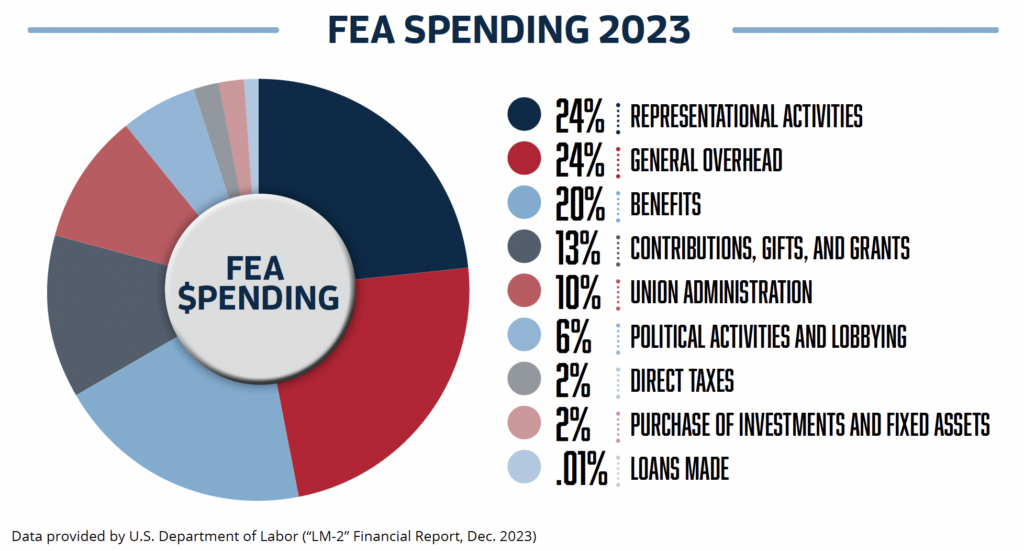Florida Education Association (FEA) represents over 130,000 teachers throughout the state of Florida. FEA is one of five teachers’ unions that is uniquely affiliated with both the National Education Association (NEA) and American Federation of Teachers (AFT). The union represents public and private sector employees, meaning it is required to file a LM-2 financial disclosure form with the United States Department of Labor. So, what does this filing reveal about the union?
FEA’s latest LM-2, which covers September 1, 2022 to August 31, 2023, reveals that FEA is not spending much to represent its membership. “Representational activities,” the spending category most closely related to labor representation, only accounted for 24.3 percent of all expenditures. What did FEA spend on instead?
Over half of FEA’s expenditures go to operating the union. During the latest reporting period, FEA spent 53 percent, or $23.3 million, on union administration, salaries, and benefits for FEA employees and general overhead expenses. These categories also account for over 80 percent of the union’s financial liabilities. Union executive salaries are included in operating expenses. Over the latest reporting period, FEA President Andrew Spar earned $314,145, nearly six times the amount of the average Florida public school teacher.
Most of the remaining 25 percent of expenditures went to political and lobbying expenditures and charitable giving. FEA spent about $5.6 million on charitable giving over the most recent reporting cycle, with most of it going to FEA locals. FEA also reported spending $2.7 million of its members’ dues on politics and lobbying, down from $3.4 million during the last reporting period.
In all, FEA spent $44.1 million over the latest reporting period, excluding transfers to affiliates (like local unions). The union brought in $43.8 million, again excluding transfers to affiliates. Almost 80 percent, or $34.8 million, of this revenue came from membership dues. FEA has seen a decline in membership, down to 136,450 from 139,476 in 2021.
While FEA’s membership has declined, the union has not opted for a broad-based membership dues increase. Instead, FEA increased the maximum dues amount from $230.14 in 2021 to $503.14 in 2023. This seems to have reaped significant financial rewards for FEA, with the union’s net assets increasing from $13.5 million in 2021 to $35.7 million in 2023. As such, FEA has increased its cash holdings from $52.1 million in 2021 to $67.7 million in 2023.

FEA’S MEMBER DUES PAY FOR POLITICS
According to federal law, member dues can be used for a variety of political activities, such as issue advocacy, get-out-thevote drives, election mailers, lobbying, and public marketing campaigns. The Janus v. AFSCME Supreme Court decision relieves nonmembers from the obligation to pay any dues or fees to the union as a condition of public employment. However, for teachers who remain FEA members, Janus changes nothing about how union dues are spent: they are still routinely used for political purposes. During the latest reporting period, FEA gave:

As previously mentioned, the FEA is associated with NEA and AFT, meaning members also pay dues to those two unions. For more information on how FEA’s affiliates spend dues, see the links below